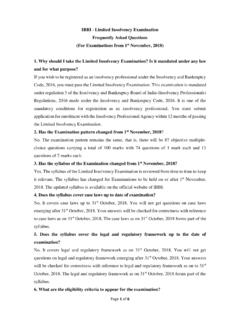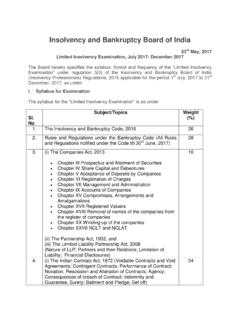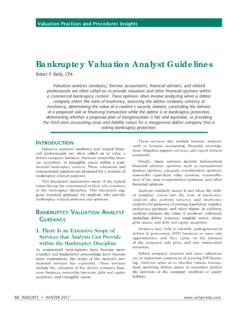Transcription of July - September, 2017 | Vol. 4 Insolvency and Bankruptcy …
1 Insolvency andBankruptcy NewsJuly - September, 2017 | Vol. 4 The Quarterly Newsletter of the Insolvency and Bankruptcy Board of IndiaBalancing the Interests of StakeholdersCONTENTFrom the Desk of the Chairperson 03 IBBI Updates 04n Visit of Hon ble Minister of State for Corporate Affairsn Strategy Meetn Disciplinary Committeen Advisory Committeesn Dr. (Ms.) Mamta Suri joins as Executive Directorn Employees Service Regulationsn Internship GuidelinesRegulations 05n Amendments to CIRP and Fast Track Regulationsn Amendments to Information Utilities Regulationsn Public Comments invited on Regulationsn Technical Committee for Information Utilitiesn Working Group on Individual Insolvency and BankruptcyNotifications 07n Reconstitution of Financial Stability and Development Counciln Facilitation by SEBIn Facilitation by
2 RBIT ransactions 08n Corporate Insolvency Resolution Processn First Resolution Plann CIRP of Jaypee Infratechn Voluntary LiquidationsOrders 09n Supreme Courtn High Courtn National Company Law Appellate Tribunaln National Company Law TribunalService Providers 13n Insolvency Professionalsn Limited Insolvency Examinationn Insolvency Professional Agenciesn Insolvency Professional Entitiesn Information UtilitiesEvents 14n National Conference on Insolvency and Bankruptcy : Changing Paradigmn Decoding the Insolvency and Bankruptcy Code, 2016 Hon ble Minister for Finance,Corporate Affairs and Defence atNational Conference on Insolvency andBankruptcy: Changing Paradigm on19th August 2017 at Insolvency and Bankruptcy NewsInsolvency and Bankruptcy news 03 From the Desk of the ChairpersonThe Committee of Creditors needs to act in the best interest of all the stakeholders of the corporate debtor.
3 A corporate is an amalgam of various stakeholders. It is expected to maximise the value of its assets and consequently the interests of all its stakeholders. However, it may not always have the motivation to maximize the value of a corporate and/or promote the interests of all stakeholders simultaneously or equitably. Therefore, the law prescribes governance norms to ensure that a corporate maximizes the value of its assets, today and tomorrow, and balances the interests of all the stakeholders, and assigns the responsibility for compliance with those norms primarily to a professional, the Company Secretary, and a custodian, the Board of Directors. A corporate (other than a financial service provider) has broadly two sources of funds, namely, equity and debt.
4 Usually, the equity owners control and run the corporate. The Insolvency and Bankruptcy Code, 2016 (Code), however, envisages that if they fail to service the debt, the corporate in default undergoes corporate Insolvency resolution process (CIRP). An Insolvency Professional (IP) carries on the business operations of the corporate as a going concern until the Committee of Creditors (CoC) draws up a resolution plan that would keep the business of the corporate going on for ever. The Code, as stated in the long title, requires a CIRP to (a) maximise value of assets of the corporate, and (b) while doing so, balance the interests of all the stakeholders, and assigns this responsibility primarily to the IP, and the CoC comprising non-related financial Code maximizes the value by striking a balance between resolution and liquidation.
5 It encourages and facilitates resolution in most cases where creditors would receive at least as much as they would in liquidation. This would happen where enterprise value is sufficiently higher than the liquidation value. In such cases, resolution preserves and maximizes the enterprise value as a going concern. In the remaining cases, the Code facilitates liquidation as that maximizes the value for stakeholders. The Code enables initiation of CIRP at the earliest, even at the very first default, when enterprise value is usually higher than the liquidation value and hence the CoC has the motivation to resolve Insolvency of the corporate rather than liquidate it. It mandates resolution in a time bound manner to prevent decline in enterprise value with time, reducing motivation of the CoC to opt for liquidation.
6 It facilitates resolution; makes a cadre of professionals available to run the corporate as a going concern; prohibits suspension or termination of supply of essential services; enables raising interim finances required for running the corporate; contrast, the Code prohibits any action to foreclose, recover or enforce any security interest during CIRP and thereby prevents a creditor(s) from maximising his interests. It expects the creditors to recover their default amounts collectively from future earnings of the corporate rather than from sale of its assets. In the matter of Prowess International Pvt. Ltd. Vs. Parker Hannifin India Pvt. Ltd., the NCLAT reiterated: It is made clear that Insolvency Resolution Process is not a recovery proceeding to recover the dues of the creditors.
7 Further, the Code enables a financial creditor to trigger CIRP even when the corporate has defaulted to another creditor and thereby prevents any preferential treatment to a creditor over others. In the matter of Parker Hannifin India Pvt. Ltd. Vs. Prowess International Pvt. Ltd., the NCLT observed: The nature of Insolvency petition changes to representative suit and the lis does not remain only between a creditor and the corporate debtor. Resolution maximizes the value of assets of the corporate and enables every stakeholder to continue with the corporate to share its fate. All of them stand to gain or lose from resolution, while stakeholders in a category receive similar treatment. In contrast, liquidation allows satisfaction of their claims one after another.
8 If there is any surplus after satisfying the claims of one set of stakeholders fully, the claim of the next set of stakeholders is considered. On both counts, maximization of value of assets and balancing the interests, resolution triumphs over recovery as well as liquidation in most cases. Balancing interests under CIRP assumes significance as every corporate may not have enough resources at the commencement of CIRP to satisfy the claims of all stakeholders fully, while resolution provides an opportunity to the CoC to consider and balance their interests. In fact, the Code prescribes several balances in resolution process: repayment of at least liquidation value to operational creditors; repayment of interim finance in priority; approval of resolution plan by 75% voting power; etc.
9 The CIRP regulations also provide for several balances. They allow a dissenting financial creditor to exit at the liquidation value and thereby protect its interests. Many creditors, however, may not like to exit at the liquidation value. And those who exit, leave the enterprise value behind. This balances the interests of financial creditors inter-se while tilting the balance in favour of resolution. The regulations also require a resolution plan to include a statement as to how it has dealt with the interests of all stakeholders, including financial creditors and operational creditors, of the corporate debtor. The judicial pronouncements require consideration of the interests of all stakeholders in a resolution.
10 In the matter of Prowess International Pvt. Ltd. Vs. Parker Hannifin India Pvt. Ltd., the NCLAT held: In the circumstances, instead of interfering with the impugned order, we remit the case to the Adjudicating Authority for its satisfaction whether the interest of all stakeholders have been satisfied .. In the matter of Prabodh Kumar Gupta Vs. Jaypee Infratech Limited and others, the NCLT observed: ..the position of present petitioner is undisputedly of stakeholders. Therefore, the IRP appointed by this Court in respect of the corporate debtor Balancing the Interests of Stakeholders04 Insolvency and Bankruptcy Newscompany is equally expected to consider and take care of the interests of the The Legislative Guide on Insolvency Law of the United Nations Commission on International Trade Law reiterates these norms: When a debtor is unable to pay its debts and other liabilities as they become due, most legal systems provide a legal mechanism to address the collective satisfaction of the outstanding claims from assets (whether tangible or intangible) of the debtor.













